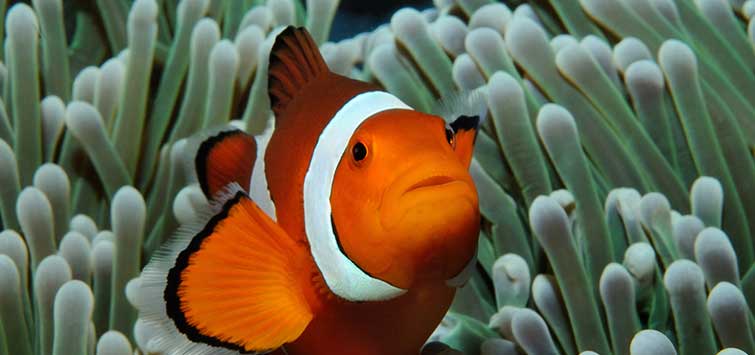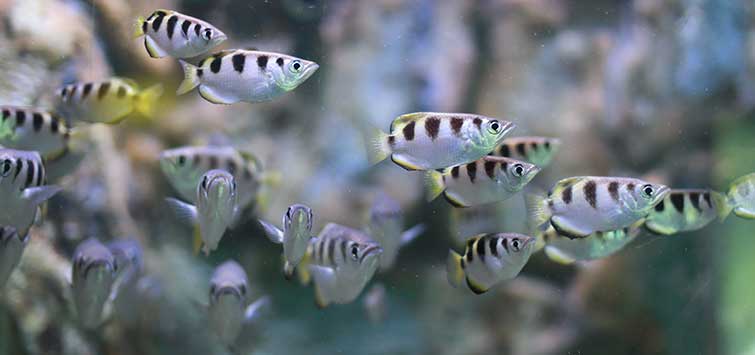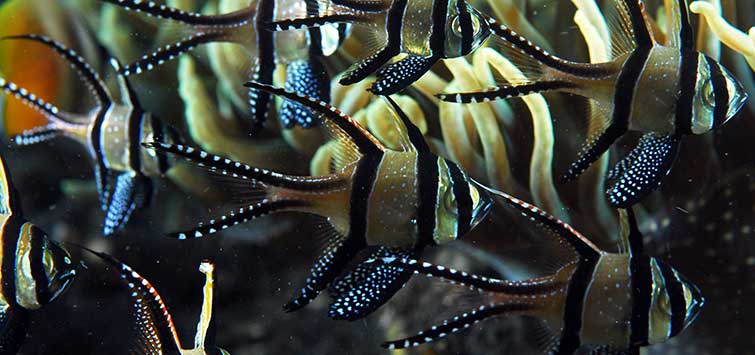The Percula Queen: A Successful Woman in the Marine Ornamental Trade
Author: Ronet Santos and Jonathan Nacario, Marine Aquarium Council, Philippines
In the male-dominated world of the marine ornamental fishery, Emelita Ampong, also known as Emy, stands out. Emy is a 37-year-old mother of two children, and in her village of New Busuanga, in the Province of Palawan, Philippines, she is the only female marine aquarium fish collector. Over the years, she has specialized in collecting false percula clownfish Amphiprion ocellaris, which has led her community to refer to her as the “Percula Queen.”
Many Filipinos use the common name “percula clown” when referring to the false percula clownfish; the true percula clownfish Amphiprion percula is not found in the Philippines. As a very dedicated marine ornamental fisherwoman, Emy also collects other species found in shallow waters, such as the copperband butterflyfish Chelmon rostratus and blue-green chromis Chromis viridis.
Emy’s Journey
Emy started out as a fisher of food fishes using hook and line, trapping crabs, and collecting seahorses—until a CITES listing for seahorses was issued in 2004. Even though she still catches food fish and traps crabs from time to time, her marine aquarium fish collection activity has significantly transformed her livelihood. Indeed, with her marine ornamental activity, she has seen her income increase, as well as become more diverse and more stable. On average, she collects about 30 “perculas” per collection trip, for which she earns between 200 and 300 Philippine pesos (which is equal to about 4 to 6 U.S. dollars).
While she also has small occasional jobs, her ornamental fish collection activity represents the largest portion of her income, and this has driven her overall income higher than the average national daily wage rate of 268 pesos.
Routine
To become successful within her community, Emy has developed a very precise routine. On one hand, she collects only young clownfish, which are still considered as being medium-sized by most marine aquarium fish exporters. Additionally, she also follows a very precise schedule by marking sea areas where percula nests can be found, and then rotating between nests for each of her visits.
CAMP
As part of the resources management plan implemented in her area through Marine Aquarium Council (MAC) Certification, Emy and the rest of the collectors of her community have agreed to collect only species within their respective total allowable catch (TAC) limit. Developed upon the scientific recommendations of Reef Check, an international non-governmental organization collaborating with MAC, the TAC is defined on a yearly basis as part of the Collection Area Management Plan (CAMP). This plan provides fishers a catch limit per species which ensures a sustainable management of the reefs and its stocks.
No-Take Zones
Aside from the TAC, the allocation of no-take zones (NTZ) is another tool used to protect some marine areas. No fishery activities are allowed within the NTZ. These areas are part of the CAMP that collectors and municipal governments are implementing. The management plan is developed by the local community and the local government as part of their efforts to consolidate their stewardship over local marine resources.
Committed to a responsible marine ornamental trade activity, Emy’s community’s marine ornamental and food fish collectors have already agreed to establish more than 170 hectares (about 2/3 square mile) of their municipal waters as a NTZ. Their local government is now finalizing the municipal ordinance for the declaration of this no-take zone.
Training
As part of the MAC Certification program, MAC trainers have conducted in-water training on non-destructive collection, handling, and holding methods of marine aquarium fish. In collaboration with another international non-governmental organization, the Conservation and Community Investment Forum (CCIF), other trainings have also been conducted to improve the business skills of Emy and the others.
Benefits of MAC Certification
Marine ornamental exporters are experiencing the positive benefits of the improved capacity of MAC-Certified collectors who have been through the MAC Certification training. Many exporters have lately made very positive comments about the improved quality of the fish arriving from New Busuanga and other localities. This is the result of the intervention of MAC, Reef Check, and CCIF. As exporter Marivi Laurel, from Aquarium Habitat Enterprises, exclaimed, “Very good shipment! The best we have received this week... Keep up the good work.”
This is a good sign for this community. This collection area in New Busuanga is to be assessed for compliance with the MAC Ecosystem and Fishery Management (EFM) and Collection, Fishing, and Holding (CFH) international standards in order to become MAC Certified.
Looking Ahead
Emy and the other collectors are looking forward to that special day with guarded anticipation. “With the help of MAC and its partners, we know better how to manage our reefs,” says Emy, with conviction reflecting her dedication to promoting a sustainable and responsible marine aquarium trade that ensures she can keep fishing into the future to support her family.
For more information about the Marine Aquarium Council and its Certification scheme, or to find an updated list of MAC-Certified collection areas and companies, please visit the MAC website at www.aquariumcouncil.org.
For any additional information, please contact MAC at info@aquariumcouncil.org.

.png?h=595&iar=0&w=2781&hash=5FD5E69473BCC22199FBFA2FB71B6033)



